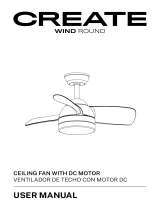Craftmade AT52 Guide d'installation
- Catégorie
- Ventilateurs ménagers
- Taper
- Guide d'installation

P. O. Box 1037
650 S. Royal Lane, Suite 100
Coppell, TX 75019 EE.UU.
(800) 486- 4892
8:00 a 5:00 CST (Hora local central)
Número de fax sin cargo: (877) 304-1728
Correo electrónico:
www.craftmade.com
P. O. Box 1037
650 S. Royal Lane, Suite 100
Coppell, TX 75019 EE.UU.
de 8 heures à 17 heures (Heure standard du centre)
Numéro de télécopieur gratuit : (877) 304-1728
Email: [email protected]
www. craftmade.com
P.O. Box 1037
650 S. Royal Lane, Suite 100
Coppell, TX 75019
(800) 486-4892
8:00 to 5:00 CST (Central Standard Time)
Toll Free Fax: (877) 304-1728
email: [email protected]
www.craftmade.com
BETTER BY DESIGN
Riata Ceiling Fan
RT52

Problèmes fréquents
Problème A : Le ventilateur ne démarre pas
Solution : 1. Vérifiez les fusibles ou le disjoncteur et remplacez-les si besoin est.
2. Coupez l'alimentation électrique et vérifiez tous les connecteurs.
3. Vérifiez les interrupteurs on/off ainsi que l'interrupteur de commande
mural. Consultez le mode d'emploi.
Problème B : Le ventilateur fait trop de bruit
Solution : 1. Vérifiez que toutes les vis du ventilateur sont serrées et correctement
installées
2. Assurez-vous que le support de montage est correctement installé.
3. Assurez-vous que le kit d’éclairage et le verre ont été correctement
réinstallés et fixés.
4. Si vous utilisez une commande murale, assurez-vous qu'il ne s'agit pas
d'un transformateur ou d'une commande à vitesse variable.
Problème C : Le ventilateur oscille
Solution : 1. Vérifiez que toutes les pales sont correctement vissées sur les
supports de pales.
2. Vérifiez que tous les supports de pales sont vissés fermement sur le
moteur.
3. Vérifiez le poids des pales. Toutes nos pales sont pesées sur des balances
électroniques. Le poids est marqué sur le dos de la pale, à côté de l'extrémité
du moteur. Toutes les pales doivent avoir le même poids pour que le
ventilateur n’oscille pas.
4. Un kit d'équilibrage des pales est fourni avec l'appareil.
Poids: un ventilateur complet, c'est-à-dire avec le matériel d'assemblage, pèse
25.1 lbs. (11.4 kg).
Tools You Need
1. Phillips Screwdriver 3. Needle Nose Pliers 2. Adjustable Wrench
Read and Save These Safety Precautions
1. Turn off electricity at main switch before wiring or servicing fan in order to avoid
possible electrical shock.
2. All wiring must be in accordance with the National Electric Code (ANSI/NFPA
70-1999) and local electrical codes. Electrical installation should be performed by a
qualified licensed electrician.
3. After making the wire connections, the wires should be spread apart with the grounded
conductor and the equipment-grounding conductor on the one side of the outlet box
and the ungrounded conductor on the other side of the outlet box.
4. The splices after being made should be turned upward and pushed carefully up into the
outlet box.
5. Conductor of a fan identified as grounded conductor to be connected to grounded
conductor of power supply, conductor of a fan identified as ungrounded conductor to
be connected to an ungrounded conductor of power supply, conductor of fan identified
for equipment grounding to be connected to an equipment-grounding conductor.
6. Fan should not be mounted in an area where it might get wet.
7. To reduce the risk of fire, electric shock or personal injury, mount to outlet box marked
"Acceptable for Fan Support" and use mounting screws provide with the outlet box.
8. For safety and best operating results, we recommend that you have a qualified
electrician assemble and install your fan.
9. WARNING: To reduce the risk of fire or electric shock, do not use this fan with any
solid state speed control device.
10. To reduce the risk of personal injury, do not bend the blade brackets when installing
the brackets, balancing the blades or cleaning the fan. Do not insert foreign objects in
between rotating fan blades.
Before Assembly
1. Make sure that the fan voltage (120) is compatible with your own electrical system.
2. Check to make sure that your carton contains all the parts mentioned in the parts
list.
NOTE: When the motor is taken out of carton, please put it in a soft cloth to prevent
any damage on the ornamental surface.
CAUTION: Before installing, choose a location for mounting the fan where the blades
have at least 7 feet of clearance from all objects and floor. Mount an outlet box to the
ceiling or use an existing box.
CAUTION: Do not mount fan to sheet rock or drywall type materials. To insure proper
support, use the two #1 wood screws to secure mounting bracket to joist or beam. If the
location you choose does not have a suitable support beam, install a 2”X4” brace between
ceiling joists to support.

Connexions électriques (suite)
Fil de terre
Noir
Blanc
Blanc
Vert
Éclairage en option
Noir
Bleu
Interrupteur
d’éclairage
Figure B
Fil de terre
Noir
Blanc
Blanc
Vert
Éclairage en option
Noir
Bleu
Interrupteur
d’éclairage
Interrupteur
du ventilateur
Noir
Figure C
What You Have
Parts Quantity
1. Mounting Bracket 1
2. Down Rod Assembly 2
6" Rod Supplied
3. Canopy 1
4. Flange Cover 1
5. Fan Housing & Motor 1
6. Blade arms 5
7. Blades (sold separately) 5
8. Switch Housing Assembly 1
9. Balance Kit 1
12
3
6
Screw Package Quantity
S1. Wood Screws 2
S2. Screws (for Canopy) 3
S3. Bracket Screws & Washer 2
S4. Blade Screws 16
S5. Motor Screws (4 screws on motor) 11
S6. Wire Connectors 3
S7. Safety Bolt & Nut 1
S8. Pull Chains 1
S9 Switch Housing Screws 3
S10. "J" Hook 1
S11. Zip Tie 1
S2
S3
S6
S5
S1
S4
4
8
5
S10 S11
S9
S8
®
S7
7

Step 1
Turn off circuit breakers and wall switch to the fan
supply line leads.
Warning: Failure to disconnect power supply prior to
installation may result in serious injury or death.To
reduce the risk of shock, this fan must be installed with
an isolating wall control/switch.
1
Step 3
Check to make sure blades are at
least 30” from any obstruction.
Check downrod length to
ensure blades are at least
7' above the floor.
3
84”
(2.1m)
Min.
30”
0.75m
Min.
Preparation
Important: When using an existing outlet box, be sure the box is securely
attached to the building structure and can support the full weight of the fan.
Failure to do so can result in serious injury or death.
Step 2
Determine mounting method to use.
A. Downrod Mount
B. Angle Mount
Craftmade Part #45AD (see dealer)
2
IMPORTANT: If using the angle mount
method, check to make sure the ceiling angle
is not steeper than 35∞. Angles greater than
35∞ will require a 45∞ angle adapter.
Downrod Installation
(Vaulted Ceilings)
Downrod Installation
(Normal Ceilings)
15
Connexions électriques
Branchez les fils bleu et noir du ventilateur (s’ils sont fournis) sur le fil noir de la
boîte de sortie. Connectez le fil blanc du ventilateur au fil blanc de la boîte de
sortie et connectez le fil de terre vert sortant du conducteur de mise à la terre au
circuit d'alimentation (voir la figure A). Utilisez les connecteurs fournis avec
votre ventilateur. Il ne peut y avoir de fil ou de connexion desserrée. Une fois
que les fils ont été connectés, ils doivent être séparés de manière à ce que les fils
vert et blanc soient d'un côté de la boîte de sortie et que les fils noir et bleu
soient de l'autre côté. Faites pivoter les épissures vers le haut et faites
soigneusement rentrer tous les fils dans la boîte de sortie. Consultez les figures B
ou C pour obtenir un câblage différent, vous permettant de contrôler votre
ventilateur à partir du mur.
Les interrupteurs muraux utilisés doivent être homologués UL pour pouvoir
fonctionner avec des ventilateurs de plafond.
REMARQUE : assurez-vous que l'interrupteur on/off [marche arrêt] du ventilateur est
toujours sur « HIGH SPEED » si votre ventilateur est commandé par un interrupteur
mural supplémentaire.
Fil de terre
Noir
Blanc
Bleu
Vert
Blanc
Vert
Éclairage en option
Figure A

4
OUTLET BOX
Outlet Box (A)
Mounting Bracket (1)
Bracket Screws
& Washers (S3)
Support Beam
Wood Screws (S1)
Canopy Screws (S2)
Ceiling
Wood Screws (S1)
“J” Hook (S10)
Fan Motor Housing
Hanging Ball
Lock Pin
Downrod
Ball Screw
Green Ground
Wire
Downrod
Assembly
(#2)
5
Step 5
Locate downrod
assembly (#2). Loosen
ball screw on black
hanging ball to free lock
pin. Black hanging ball
will slide down. Remove
ground screw and green
ground wire. Remove
hanging ball from
downrod and save all
parts. Insert fan wires
through downrod. Screw
downrod into top of fan
motor housing, being
careful that wires are
pulled through.
14
13
Installation du kit d'éclairage en option
Retirez trois vis de la partie latérale du moyeu d'interrupteur (comme le
montre l'illustration ci-dessous). Retirez le couvercle du moyeu et faites
sortir la prise centrale. Filetez soigneusement les fils sortant du kit
d'éclairage à travers le trou central du couvercle de moyeu. Attachez le kit
d'éclairage sur le couvercle de moyeu en vissant en la partie centrale du
faisceau de fils sortant du kit d'éclairage sur la partie centrale du couvercle
de moyeu. Fixez le faisceau de fils à l’intérieur du moyeu à l’aide de l'écrou
de 3/8 po fourni. Attachez le fil blanc du kit d'éclairage au fil blanc du
moyeu, à l'aide du coinceur à câbles. Ensuite, attachez le fil noir sortant
du kit d'éclairage au fil bleu du moyeu d'interrupteur. Enfoncez
soigneusement les fils dans le moyeu et replacez le couvercle de ce dernier
à l'aide des vis enlevées précédemment.
Vis
Assemblage du boîtier de
l'interrupteur
Prise centrale
Vis centrale
Enlever finial
Interrupteur à
glissière
Chaîne de traction
du moteur
Chaîne de traction
de l’éclairage
ATTENTION: même si les pales de votre ventilateur sont installées à plus 2 mètres du
sol, évitez toujours de placer vos bras ou tout objet sur leur chemin de rotation.
Chaîne de
force de Uplight
Mode d'emploi
1. La séquence de fonctionnement de la chaîne de traction/interrupteur du moteur est
OFF-HI-MED-LOW.
2. Faites glisser l'interrupteur vers la DROITE pour faire tourner le ventilateur EN
AVANT ou faites-le glisser vers la GAUCHE pour faire tourner les pales dans l'autre
sens.
3. La chaîne de traction/interrupteur de l’éclairage a deux positions : ON/OFF
[MARCHE/ARRÊT].
4. La chaîne de traction/interrupteur de l’éclairage vers le haut a deux positions :
ON/OFF. REMARQUE : l’éclairage vers le haut nécessite 3 ampoules candélabres de
60 W. (Non fournies).
Step 4
Prior to securing mounting bracket, screw "J" hook (S10) into ceiling outlet box
as a secondary support means. Secure mounting bracket (1) to the outlet box
(A) by tightening bracket screws & washers (S3) as shown. If not mounting to
an outlet box, use wood screws (S1) and washers (S3) and mount securely to
ceiling beam. Be sure at this point to insert canopy screws (S2) in bracket.
NOTE: Do not mount directly to sheet rock or ceiling tile.
NOTE: J Hook installation is a Canadian requirement only.

6
Step 6
Position downrod so the hole in the downrod aligns with the hole in the
coupling on the motor. Insert safety bolt (S8) through coupling and
downrod and attach nut. Tighten firmly. Tighten set screw "A" against
downrod. Place flange cover (5) over downrod assembly until it covers
flange. Place canopy (3) over downrod (2). Replace hanging ball, insert
hanging pin through downrod and tighten set screw "C" in hanging ball
into downrod.
NOTE: Flange cover will not work with supplied 2 1/2 inch downrod. Flange cover is
decorative and will not affect the operation of the fan.
Ground
Wire
Ball
Screw
Hanging
Pin
Hanging
Ball
ThreadedSet
Screw Hole
WARNING:
Failure to completely tighten downrod as described in steps 5 & 6 above could
result in the fan loosening and possibly falling.
Set Screw (A)
Canopy (3)
Set Screw (C)
Downrod (2)
Flange Cover (4)
Safety Bolt &
Motor Housing (7)
12
Étape 12
1. Pour installer l'assemblage de boîtier d'interrupteur (n∞ 8), repérez les
prises de câblage modulaire (A) et (B). L'une d'entre elles sort de la plaque
de montage (E), au bas du corps du ventilateur et l'autre sort du boîtier
d'interrupteur (n∞ 8). Alignez les deux prises de manière à ce que les
verrous situés sur leurs côtés puissent s'enclencher. Enfoncez fermement les
deux prises jusqu'à ce qu'elles s’emboîtent.
2. Repérez les fils de boîtier d'interrupteur (S9). Soulevez le couvercle de
boîtier d’interrupteur (n∞ 8) et alignez les trous de montage avec les trous
de la plaque de montage (E). Une fois que les trous sont alignés, fixez le
couvercle de boîtier d'interrupteur au moyen des vis de boîtier
d'interrupteur (S9) et serrez-les fermement.
IMPORTANT : vérifiez qu'aucun fil n'a été coincé ou pincé durant le montage.
ATTENTION
Pour réduire les risques de blessures corporelles, NE tordez PAS les bras de pale
lorsque vous les installez. Lors de l'équilibrage des pales ou du nettoyage du
ventilateur, n'insérez pas d'objets étrangers entre les pales d'un ventilateur en
mouvement.
Prises de câblage modulaire (A)
Plaque de montage (E)
Prises de câblage
modulaire (B)
Assemblage du boîtier
de l'interrupteur
(8)
Vis (F)
Fentes de
montage (D)

11
Étape 11
Installation des 5 pales
Enlevez les coussinets de mousse et conservez les vis de moteur pour
l’installation des pales. À l’aide des vis de moteur fournies (S5), alignez
les trous du bras de pale avec ceux du boîtier de moteur. Serrez
fermement les vis.
7
Step 7
For added security, attach safety cable from fan unit to "J" hook (S10) in
outlet box. Secure by looping zip tie (S11) through safety cable and "J"
hook. Tighten zip tie securely. Lift fan onto the mounting bracket (1).
Turn housing until hanging ball seats itself into ball socket (listen for
click).
NOTE: Parts furnished will allow
you to install your fan at up to a 35
∞ angle. Angles greater than 35∞
will require a 45∞ angle adapter
(see dealer). NOTE: J Hook
installation is a Canadian
requirement only.
Outlet Box (A)
Support Beam
Ceiling
Green Ground Wire
“J” Hook (S10)
OUTLET BOX
“J” Hook (S10)
Safety Cable
Zip Tie (S11)
Mounting Bracket (1)
WARNING: To reduce the risk of fire, electric shock or personal injury, mount
so outlet box marked "acceptable for fan support" and use mounting screws
provided with the outlet box. Most outlet boxes commonly used for the support
of lighting fixtures are not acceptable for fan support and may need to be
replaced. Consult a qualified electrician if in doubt.

Step 8
1. Connect fan wires to ceiling wires: white fan wire to white outlet wire,
black to black and green to green. Wire connectors (S6) are provided for
your convenience. If an additional blue wire is present then also connect
the blue wire to the black wire. (Optional light kit may be wired to
individual wall switches, if desired.)
2. After connections
are made, turn
splices upward
and push carefully
into outlet box.
Separate blue and
black wires on one
side of the box, and
white and green wires
on the other side.
There are 4 colored
wires coming from the
top of the motor
(including ground wire).
8
White (Neutral)
Ground
White
Black
Wire
Connectors
(S6)
Ground
(Green)
Blue
Black (Power)
Mounting Bracket
Ground (Green)
Outlet Box
Ground (Green)
Wire Connnections
Outlet Box Fan wires
Black Black
(Hot wire for fan)
Green Green (Ground wire)
White White (Neutral wire)
Black Blue (Light kit wire)
9
Étape 9
Fixez la coupelle (n∞ 3) au
support de montage en insérant
les vis (S2) dans ses fentes.
Faites-la tourner dans le sens
des aiguilles d'une montre pour
l'installer. Serrez fortement les
vis.
Partie inférieure
de la coupelle
Vis (S2)
Coupelle (n∞ 3)
Plafond
10
Étape 11
Pour monter les pales, placez le support de pales (n∞ 6) et la pale (n∞ 7)
de manière à ce que les trous de vis soient alignés comme sur la figure
ci-dessous. Insérez les vis des pales (S4) dans la partie supérieure du
support de pales, à travers la pale et dans la décoration de la pale.
Serrez-les fermement.
Vis de pale (S4)
Bras de pale (n∞ 6)
Pale (n∞ 7)
Vis de moteur (S5)
ATTENTION: ne fixez les supports de pales au moteur que lorsque ce dernier
est totalement installé. Ainsi vous n'endommagerez pas les supports de pale qui
ont été soigneusement équilibrés.
IMPORTANT: enlevez les coussinets de mousse en caoutchouc et conservez les
vis de moteur pour l’installation.
Downrod Ground
(Green)

9
Step 9
Attach canopy (3) to the
mounting bracket by placing
screws (S2) into slot in canopy.
Twist clockwise to lock
into place. Tighten screws
firmly.
Bottom of Canopy
Screws (S2)
Canopy (3)
Ceiling
Étape 8
1. Connectez les fils du ventilateur à ceux du plafond : le fil de ventilateur
blanc au fil de sortie blanc, le fil noir au fil noir et le fil vert au fil vert. Les
connecteurs (S6) sont fournis au cas où vous en auriez besoin. S'il existe un
fil bleu supplémentaire, connectez-le au fil noir.
(Un kit d’éclairage en option
peut être connecté à des
interrupteurs muraux).
2. Une fois que les
connexions ont
été effectuées,
tournez les épissures
vers le haut et faites
rentrer soigneusement
le câblage dans la boîte
de sortie. Placez les fils
bleus et noirs d'un côté
de la boîte et les fils blancs
et verts de l'autre côté.
Des fils de quatre couleurs
différentes sortent du
dessus du moteur
(y compris le fil
de terre).
8
Blanc (neutre)
Fil de terre
Blanc
Noir
Connecteurs
(S6)
Fil de terre
(vert)
Bleu
Noir (alimentation)
Fil de terre de
la boîte de sortie
Fil de terre du
support
de montage (vert)
Boîte de sortie Fils du ventilateur
Noir
Noir (Fil chargé du ventilateur)
Vert
Vert (Fil de terre)
Blanc
Blanc (Fil neutre)
Noir
Bleu (Fil du kit d’éclairage)
Fils de connexion
10
Step 10
For blade assembly, position blade arm (6), blade (7) so that all screw
holes are aligned (as shown in figure below). Using blade screws (S4),
insert through top of blade holder, through blade, and into blade
ornament. Tighten securely.
CAUTION:
Install blade holders to motor only after motor installation is complete. This will
prevent damage to the blade holders which have been carefully balanced.
IMPORTANT: Remove rubber cushions, saving motor screws for installation.
Blade Screws (S4)
Blade Arm (6)
Blade (7)
Motor
Screws (S5)
Fil de terre de la
tige de suspension
(vert)

11
Step 11
5 Blade Installation
Remove rubber cushions, saving motor screws for blade installation.
Using motor screws (S5) provided, line up holes from the blade arm with
the holes in the motor housing. Tighten screws securely.
7
Étape 7
Pour plus de sécurité, attachez le câble de sécurité du ventilateur au
crochet en « J » (S10) accroché dans la boîte de sortie. Fixez l'installation
en faisant passer la bride (S11) dans le câble de sécurité et dans le crochet
en «J». Resserrez fortement la bride. Installez le ventilateur sur le support
de montage (n∞ 1). Faites pivoter le boîtier jusqu'à ce que la boule
pendante s’installe dans son réceptacle (vous devriez entendre un déclic).
NOTE: les pièces fournies vous permettront d'installer votre ventilateur à un
angle de 35∞. Pour toute installation à un angle supérieur à 35∞, vous aurez
besoin d'un adaptateur d'angle à 45∞ (consultez votre revendeur).
Boîte de sortie (A)
Poutre de soutien
Plafond
Fil de terre vert
Crochet en «J» (S10)
Crochet en « J » (S10)
Câble de sécurité
Bride (S11)
Support de montage (n∞ 1)
BOÎTE DE SORTIE
AVERTISSEMENT : Pour éviter les incendies, les décharges électriques ou les
blessures, branchez le ventilateur sur une boîte de sortie marquée « acceptable
for fan support » (prise en charge de ventilateur) et utilisez les vis de montage
fournies avec la boîte de sortie. La plupart des boîtes de sortie utilisées avec les
dispositifs d'éclairage ne prennent pas en charge les ventilateurs et doivent être
éventuellement remplacées. En cas de doute, consultez un électricien qualifié.

6
Étape 6
Placez la tige de suspension de manière à ce que son trou soit aligné avec
celui de l’attelage du moteur. Insérez le boulon de sécurité (S7) dans
l’attelage et la tige de suspension et fixez l'écrou. Serrez fermement. Serrez
la vis de fixation « A » contre la tige de suspension. Enfoncez le
couvre-bride (n∞ 4) sur l'assemblage de la tige de suspension jusqu'à ce
qu'il couvre la bride. Placez la coupelle (3) sur la tige de suspension (n∞
2). Replacez la boule pendante. Pour cela, insérez la douille pendante dans
la tige de suspension et serrez la vis de fixation « C » dans la boule
pendante jusqu'à ce qu'elle pénètre dans la tige de suspension.
NOTE : Le couvre-bride ne fonctionnera pas avec la tige de suspension de 6,35 cm (2,5
po.) fournie. Le couvre-bride est purement décoratif et n'affectera pas le fonctionnement
du ventilateur.
AVERTISSEMENT: si vous ne serrez pas complètement la tige de suspension
en suivant les instructions des étapes 5 et 6, le ventilateur peut se desserrer et
éventuellement tomber.
Fil de terre
Vis de
boule
Douille
pendante
Boule
pendante
Trou de vis
de fixation fileté
Vis de fixation (A)
Coupelle (n∞ 3)
Vis de fixation (C)
Tige de suspension (n∞ 2)
Couvre-bride (n∞ 4)
Boulon et écrou
de sécurité (S7)
Boîtier du moteur (n∞ 5)
12
Step 12
1. To install the Switch Housing Assembly (8), locate both modular
wiring plugs (A) and (B). One extends from the mounting plate (E) on
bottom of fan body and one extends from the Switch Housing (8). Align
the two plugs so the latch on the side of the plugs will engage when
pushed together. Push the two plugs firmly together until latched.
2. Locate switch housing screws (S9). Raise switch housing cover (8) and
align the mounting holes with the holes on mounting plate (E). Once the
holes are aligned, attach the switch housing cover using the switch housing
screws (S9) and tighten firmly.
IMPORTANT: Be sure that no wires are caught in mounting slots or pinched between
switch housing and mounting plate.
CAUTION
To reduce the risk of personal injury, DO NOT bend the blade arms when
installing them. When balancing the blades, or cleaning the fan, do not insert
foreign objects in between rotating fan blades.
Modular Wiring Plug (A)
Mounting Plate (E)
Modular Wiring Plug (B)
Switch Housing (8)
Screws (F)
Mounting Slots (D)

4
OUTLET BOX
Boîte de sortie (A)
Supports de montage (1)
Vis et rondelles
des supports
(S3)
Poutre de soutien
Vis à bois (S1)
Vis de coupelle (S2)
Plafond
Vis à bois (S1)
Crochet en « J » (S10)
Boîtier du moteur
du ventilateur
Boule pendante
Goupille de
verrouillage
Tige de suspension
Vis de boule
Fil de terre vert
Assemblage
de la tige de
suspension
(2)
5
Étape 5
Repérez l'assemblage de tige de
suspension (n∞ 2). Desserrez la
vis de boule située sur la boule
pendante noire pour dégager la
goupille de verrouillage. La
boule pendante noire glissera
vers le bas. Retirez la vis de mise
à la terre et le fil de terre vert.
Retirez la boule pendante de la
tige de suspension et conservez
toutes les pièces. Insérez les fils
du ventilateur à travers la tige
de suspension. Vissez la tige de
suspension dans la partie
supérieure du boîtier de moteur
du ventilateur, en faisant
attention à ce que les fils soient
complètement passés.
13
Optional Light Kit Installation
Remove three screws from side of switch hub (as shown in figure below).
Remove hub cover from hub and pop out center plug. Carefully thread
wires from light kit through the center hole in hub cover. At this point
attach light kit into hub cover by screwing center all-thread from light kit
into the center hub cover. Lock the all-thread in place on the inside of the
hub using the 3/8" nut provided. Attach white wire from light kit to
white wire in hub, using wire nuts. Next, attach black wire from light kit
to blue wire in switch hub. Carefully push wires up into hub and replace
hub cover using screws removed earlier.
Screws
Switch Hub
Center Hole
Center Screw
Remove Finial
Operation Instructions
1. The sequence of operation for the motor pull/chain switch is OFF-HI-
MED-LOW.
2. Push the slide switch RIGHT for FORWARD, and LEFT for REVERSE
action of the blades.
3. The pull chain switch for the lighting is two positions - ON/OFF.
4. The pull chain switch for the uplighting is on/off. NOTE: Uplighting takes
3-60W Candelabra bulbs (not included).
14
Slide Switch
Motor Pull Chain
Uplight Pull Chain
Light Pull Chain
CAUTION: Even if your fan is mounted with the blades more than 7 feet from the
floor, be careful to avoid placing your raised arms or any object in the path of the blades.
Étape 4
Avant de fixer le support de montage, vissez le crochet en «J» (S10) sur la
boîte de sortie du plafond, pour qu’il serve de dispositif de soutien
supplémentaire. Fixez le support de montage (n∞ 1) à la boîte de sortie
(A) en resserrant les vis (S3) et les rondelles (S4) de support de la manière
illustrée. Si vous n'installez pas le ventilateur sur une boîte de sortie,
utilisez les vis à bois (S1) et les rondelles (S4) pour installer solidement
l'appareil à une poutre du plafond. N'oubliez pas d'insérer les vis de la
coupelle (S2) dans le support. REMARQUE : n'installez pas le ventilateur
directement sur du plâtre ou sur des carreaux de plafond.

Ground
Black
White
White
Green
Optional Light
Black
Blue
Light Switch
Figure B
15
Electrical Connections
Connect black and blue (if provided) fan wires to black outlet wire.
Connect white fan wire to white outlet wire and green grounding lead
wire from the grounding conductor to the supply circuit (see figure A).
Use wire connectors provided with your fan. No loose strands or loose
connections should be present. After wires have been connected, they
must be spread apart so the green and white are on one side of the outlet
box and the black and blue are on the other side. Turn
splices upward and carefully
push all wiring into outlet
box. For optional wall
control see figure B or
Figure C for alternate wiring.
When wall switches are employed,
switches should be UL listed
for use with ceiling fan.
NOTE: Make sure fan on/off switch
is always at "high speed" location if
your fan is controlled by additional
wall switch.
Ground
Black
White
Blue
Black
White
Green
Optional Light
Figure A
Étape 3
Assurez-vous que les pales du
ventilateur sont à 75 cm (30 po)
minimum de toute obstruction.
Mesurez la tige de suspension
pour vous assurer que les pales
sont à au moins 2 mètres
(7 pi) du sol.
3
2,1 m
(84 po)
min.
0,75 m
(30 po)
min.
Préparation
Important: lorsque vous utilisez une boîte de sortie existante, assurez-vous que
cette dernière est correctement attachée à la structure du bâtiment et qu’elle peut
soutenir le poids total du ventilateur. Le non-respect de cette consigne peut
entraîner de graves blessures, voire la mort.
Étape 1
Désactivez les disjoncteurs et l'interrupteur mural
régissant les conducteurs d'alimentation du
ventilateur.
Avertissement: le non débranchement de l'alimentation électrique
avant l'installation du ventilateur peut entraîner de graves
blessures, voire la mort. Pour éviter les décharges électriques, ce
ventilateur doit être installé avec un interrupteur mural isolant
.
1
Étape 2
Choisissez la méthode de montage que
vous désirez utiliser.
A. Montage à l’aide d’une tige de
suspension
B. Montage sur une surface inclinée
Pièce Craftmade n∞45AD
(consultez votre revendeur)
2
IMPORTANT: si vous utilisez la méthode
de montage inclinée, vérifiez que l'angle du
plafond est inférieur à 35∞. Si votre plafond
est incliné à un angle supérieur à 35∞, vous
devrez utiliser un adaptateur d’angle à 45∞
Montage à l’aide d’une tige de suspension
(Plafond en pente)
Montage à l’aide d’une tige de suspension
(Plafonds normaux)

Composants inclus
Pièces Quantité
1. Support de montage 1
2. Assemblage de la tige de suspension
Tige de 6 x 15 cm (2 po x 4 po )
(Utilisez la longueur désirée) 1
3. Coupelle 1
4. Couvre-bride 1
5. Boîtier du ventilateur et du moteur 1
6. Bras de pale 5
7. Pales (vendues séparément) 5
8. Assemblage du boîtier
de l'interrupteur 1
9. Kit d'équilibrage 1
12
3
6
Paquet de vis Quantité
S1. Vis à bois 2
S2. Vis (pour coupelle) 3
S3. Vis et rondelles des supports 2
S4. Vis des pales 16
S5. Vis du moteur
(quatre vis sur le moteur) 11
S6. Connecteurs de fils 3
S7. Boulon et écrou de sécurité 1
S8. Chaînes de traction 2
S9. Vis du boîtier d’interrupteur 1
S10. Crochet en « J » 1
S11. Bride 1
S2
S3
S6
S5
S1
S4
4
8
5
S10 S11
S9
S8
®
S7
7
Common Problems
Problem A: Fan Will not Start
Remedies: 1. Check fuse or circuit breaker and replace if necessary
2. Turn off electrical power and check all wire connectors.
3. Check on/off TCS and wall control selector switch. See operation
instructions.
Problem B: Fan is Excessively Noisy
Remedies: 1. Check that all screws in fan assembly are tight and properly seated.
2. Check to make sure mounting bracket is installed properly.
3. Check to make sure light kit and glass reinstalled properly and tight.
4. If wall control is used, insure the wall control is not a transformer or
a variable speed type.
Problem C: Fan Wobbles
Remedies: 1. Check that all blades are screwed firmly into blade holders.
2. Check that all blade holders are screwed firmly into motor.
3. Check the weight of blades. All our blades are weighed on electronic
scales. The weight is marked on the reverse side of the fan blade near
the motor end. All of the blades should be the same weight to
prevent fan from wobbling.
4. A balancing kit is enclosed if needed.
Weight: The weight of the complete fan, including assembly hardware is 25.1
lbs.
Ground
Black
White
White
Green
Optional
Light
Black
Blue
Light
Switch
Fan
Switch
Black
Figure C
Electrical Connections Continued…

Veuillez lire et conserver ces consignes de sécurité
1. Pour éviter de vous électrocuter, débranchez l'alimentation électrique au niveau de
l'interrupteur principal avant de procéder au câblage ou à l'entretien du ventilateur.
2. Tout le câblage doit être effectué en accord avec le code électrique national américain
(ANSI/NFPA 70-1999) et les codes électriques locaux. L'installation électrique doit être
effectuée par un électricien professionnel qualifié.
3. Une fois que les connexions ont été effectuées, les fils doivent être séparés. Le conducteur mis
à la masse et le conducteur de mise à la masse de l'équipement doivent être mis d'un côté de
la boîte de sortie et le conducteur non mis à la masse de l'autre côté.
4. Une fois qu'elles ont été faites, les épissures doivent être tournées vers le haut et les fils
doivent être soigneusement rentrés dans la boîte de sortie.
5. Le conducteur mis à la masse du ventilateur doit être branché sur le conducteur mis à la
masse de l'alimentation électrique, et le conducteur non mis à la masse du ventilateur doit
être branché sur le conducteur non mis à la masse de l'alimentation électrique. Le
conducteur du ventilateur destiné à la mise à la masse de l'équipement doit être connecté à
un conducteur de mise à la masse de l'équipement.
6. Le ventilateur ne peut être installé dans un endroit où il pourrait être mouillé.
7. Pour éviter les incendies, les décharges électriques ou les blessures, branchez le ventilateur sur
une boîte de sortie marquée « Prise en charge de ventilateur » et utilisez les vis de montage
fournies avec la boîte de sortie.
8. Par mesure de sécurité et pour obtenir les meilleurs résultats possibles, nous vous conseillons
de faire assembler et installer votre ventilateur par un électricien professionnel.
9. ATTENTION : pour éviter les incendies ou les décharges électriques, n'utilisez jamais ce
ventilateur avec un dispositif de contrôle de la vitesse à l’état solide.
10. Pour éviter de vous blesser, ne pliez jamais les supports de pales lorsque vous les installez, les
équilibrez ou que vous nettoyez le ventilateur. N'insérez jamais d'objet entre les pales en
mouvement du ventilateur.
Avant l'assemblage
1. Vérifiez que la tension du ventilateur (120) est compatible avec votre système
électrique.
2. Assurez-vous que le carton d'emballage contient toutes les pièces mentionnées dans la
liste des pièces.
REMARQUE : une fois le moteur déballé, placez-le sur un tissu doux pour éviter que sa
surface décorée ne soit endommagée.
ATTENTION : avant de procéder à l'installation du ventilateur, choisissez un endroit où
ses pales seront à une distance d'au moins 2 m (7 pi) de tout objet environnant et du sol.
Installez une boîte de sortie au plafond ou bien utilisez une boîte existante.
ATTENTION : n'installez pas le ventilateur sur des cloisons sèches ou du plâtre. Pour
que l'appareil soit correctement fixé, accrochez les supports de montage à une poutrelle ou
à une poutre au moyen des deux vis à bois n∞ 1. Si l'emplacement choisi n'a pas de
poutre de soutien acceptable, installez une armature de 2 po X 4 po entre les poutrelles du
plafond pour y accrocher le ventilateur
Outils nécessaires à l'installation
1. Tournevis Phillips 3. Pince à becs pointus 2. Clé réglable
BETTER BY DESIGN
Ventiladores de Riata
RT52

Lea y conserve estas precauciones de seguridad
1. Apague la electricidad con el interruptor principal antes de cablear o dar servicio al
ventilador para evitar posibles choques eléctricos.
2. Todo el cableado eléctrico debe acatar los códigos eléctricos nacionales (ANSI/NFPA
70-1999) y los códigos eléctricos locales. Un electricista capacitado debe realizar la
instalación eléctrica.
3. Después de realizar las conexiones de cableado, deben separarse los cables con el
conductor a tierra y el conductor de tierra del equipo en un lado de la caja de salida y
el conductor sin tierra al otro lado de la caja de salida.
4. Una vez efectuados los empalmes deben girarse hacia arriba y empujarse con cuidado
dentro de la caja de salida.
5. El conductor de un ventilador identificado como conductor a tierra debe conectarse
al conductor a tierra de un suministro de alimentación, el conductor de un
ventilador identificado como conductor sin tierra debe conectarse a un conductor sin
tierra del suministro de alimentación; el conductor de un ventilador identificado para
conectar a tierra el equipo debe conectarse a un conductor para tal efecto.
6. No debe montarse el ventilador en un área donde pueda mojarse
7. Para aminorar el riesgo de un incendio, choque eléctrico o lesión personal, móntelo a
una caja de salida adecuada para soportar el ventilador ("Acceptable for Fan
Support") y utilice los tornillos de montaje incluidos con la caja de salida.
8. Por motivos de seguridad y para obtener óptimos resultados, recomendamos que
pida a un electricista capacitado ensamblar e instalar el ventilador.
9. ADVERTENCIA: Para reducir el peligro de incendio o choque eléctrico, no use este
ventilador con ningún dispositivo de control de velocidad de estado sólido.
10. Para aminorar el riesgo de una lesión personal, no doble los soportes de las aspas al
instalar los soportes, equilibrar las aspas o limpiar el ventilador. No introduzca
objetos extraños entre las aspas giratorias del ventilador.
Antes del montaje
1. Revise que el voltaje (120) del ventilador sea compatible con su propio sistema eléctrico.
2. Compruebe que la caja contenga todas las piezas mencionadas en la lista correspondiente.
NOTA: Cuando se extraiga el motor de la caja, póngalo sobre un paño suave para evitar dañar
la superficie ornamental.
PRECAUCIÓN: Antes de instalar, elija una ubicación para montar el ventilador donde las
aspas tengan por lo menos 7 pies (2.1 m) de altura desde el piso y todo objeto. Monte una
caja de salida en el cielo raso o use una caja existente.
PRECAUCIÓN: No monte el ventilador en materiales de tipo tablaroca o paneles de yeso.
Para asegurar un soporte adecuado use los dos tornillos para madera (1) para asegurar el
soporte de montaje a la viga. Si la ubicación que ha seleccionado no tiene una viga de soporte
que sirva, instale una abrazadera de 2" x 4" (5 x 10 cm) entre las vigas del cielo raso para
soportar el ventilador.
Herramientas necesarias
1. Destornillador Phillips 3. Alicates de punta 2. Llava ajustable
BETTER BY DESIGN
Ventilateurs de plafond Riata
RT52

Componentes Incluidos
Piezas Cantidad
1. Soporte de montaje 1
2. Ensamblaje de vara hacia 2
abajo, se suministra vara
de 6 pulg. (15 cm)
3. Cúpula 1
4. Cubierta de la brida 1
5. Caja del ventilador y motor 1
6. Brazos de las aspas 5
7. Aspas (se venden por separado) 5
8. Ensamblaje de la caja del interruptor 1
9. Juego de equilibrio 1
12
3
6
Paquete de herraje Cantidad
S1. Tornillos para madera 2
S2. Tornillos (para la cúpula) 3
S3. Tornillos de soporte y arandela 2
S4. Tornillos de las aspas 16
S5. Tornillos del motor
(4 tornillos en el motor) 11
S6. Conectores de cables 3
S7. Perno y tuerca de seguridad 1
S8. Cadenas 1
S9. Tornillos de la caja del interruptor 3
S10. El Cancho "J" 1
S11. Amarra 1
S2
S3
S6
S5
S1
S4
4
5
S10 S11
S9
S8
®
S7
87
Problemas Comunes
Problema A: El ventilador no arranca
Soluciones: 1. Revise el fusible o disyuntor y cámbielo si es necesario.
2. Apague la alimentación eléctrica y revise todos los conectores de cables.
3. Inspeccione el interruptor TCS de encendido / apagado y el interruptor
selector de control para la pared. Consulte las instrucciones de
funcionamiento.
Problema B: El ventilador es demasiado ruidoso
Soluciones: 1. Revise que estén apretados y debidamente asentados todos los tornillos
del ensamblaje del ventilador.
2. Compruebe que el soporte de montaje esté instalado correctamente.
3. Compruebe que la unidad de luz y el vidrio estén correctamente
instalados y apretados.
4. Si se usa el control de pared, revise que no sea del tipo transformador o
de velocidad variable.
Problema C: El ventilador se balancea
Soluciones: 1. Revise que todas las aspas estén atornilladas firmemente en sus soportes.
2. Revise que todos los soportes de las aspas estén atornilladas firmemente
en el motor.
3. Revise el peso de las aspas. Todas nuestras aspas se pesan en balanzas
electrónicas. El peso aparece en el reverso del aspa cerca del extremo del
motor. Todas las aspas deben tener el mismo peso para evitar que el
ventilador se balancee.
4. Se adjunta un paquete de balanceo, si es necesario.
Peso: El peso del ventilador completo, incluido el herraje de montaje es de
25.1 lbs. (11.4 kg).
Tierra
Negro
Blanco
Blanco
Verde
Luz opcional
Negro
Azul
Interruptor
de luz
Interruptor del
ventilador
Negro
Figura C
Conexiones eléctricas continuación…

Paso 1
Apague los disyuntores y el interruptor de la pared
hacia los conductores de suministro del ventilador.
Advertencia: Si no se desconecta el suministro de
alimentación antes de la instalación puede ocasionar
lesiones graves o fatales. Este ventilador debe instalarse
con un interruptor/control aislante de pared para reducir
el riesgo de electrochoque.
1
Preparación
Importante: Al utilizar una caja de salida existente, revise que la caja esté
conectada firmemente a la estructura de la edificación y que pueda soportar el
peso total del ventilador. De lo contrario puede ocasionar lesiones graves o fatales.
Paso 3
Revise que las aspas queden por lo
menos a 30” (76 cm) de toda
obstrucción. Compruebe la
longitud de la vara hacia abajo
para que las aspas queden por
lo menos a 7 pies (2 metros) del
piso.
3
84 pulg
(2.1m)
Mín.
30 pulg
0.75m
Mín.
Paso 2
Determine el método de montaje a
usar.
A. Montaje con vara hacia abajo
B. Montaje angular
Pieza Craftmade 45AD
(consulte al distribuidor)
2
IMPORTANTE: Si utiliza el método de
montaje angular, revise que el ángulo del cielo
raso no supere los 35∞. Los ángulos mayores
de 35∞ necesitarán un adaptador angular de
45∞.
Instalación con vara hacia abajo
(cielos rasos abovedados)
Instalación con vara hacia abajo
(cielos rasos normales)
15
Verde
Tierra
Negro
Blanco
Blanco
Luz opcional
Negro
Azul
Interruptor
de luz
Figura B
Conexiones eléctricas
Conecte los cables negro y azul (si se incluyen) al cable de salida negro.
Conecte el cable blanco del ventilador con el cable de salida blanco y el
cable conductor de tierra verde desde el conductor de tierra al circuito de
suministro (consulte la figura A). Use los conectores de cable provistos con
el ventilador. No debe haber hebras ni conexiones sueltas. Después de
conectar los cables, deben separarse de tal modo que el verde y el blanco
queden en un lado de la caja de salida y el negro y el azul queden en el
otro
lado. Gire los empalmes hacia
arriba y empuje con cuidado
todo el cableado dentro de la
caja de salida. Para el control opcional
de pared, consulte la figura B o la
figura C para ver cableados alternativos.
Cuando se empleen los interruptores de
pared, éstos deben estar listados por UL
para utilizarse con ventiladores de techo.
NOTA: Revise que el interruptor de
encendido y apagado siempre esté en la
“velocidad alta” si el ventilador se controla
mediante un interruptor adicional de pared.
Tierra
Negro
Blanco
Azul
Negro
Blanco
Verde
Figura A
Luz opcional

Paso 4
Antes de sujetar el soporte de montaje, atornille el gancho “J” (S10) en la
caja de salida del techo como medio de soporte secundario. Asegure el
soporte de montaje (1) a la caja de salida (A) apretando los tornillos del
soporte y las arandelas (S3) como se muestra. Si no se monta en una caja
de salida, use tornillos para madera (S1) y arandelas (S3), montando
firmemente en una viga del cielo raso. En este punto deben insertarse los
tornillos de cúpula (S2) en el soporte.
NOTA: No monte directamente en paneles de yeso o láminas de techo.
NOTA: La instalación del Gancho J es un requisito canadiense sólo.
4
OUTLET BOX
Caja de salida (A)
Soporte de montaje (1)
Tornillos de soporte
y arandelas (S3)
Viga de soporte
Tornillos para madera (S1)
Tornillos para
la cúpula (S2)
Cielo raso
Tornillos para madera (S1)
CAJA DE SALIDA
Gancho “J”(S10)
Caja del motor
del ventilador
Bola colgante
Pasador
de bloqueo
Vara hacia abajo
Tornillo de bola
Cable verde
a tierra
Ensamblaje
de la vara
hacia abajo
(2)
5
Paso 5
Ubique el ensamblaje de la
vara hacia abajo (2). Suelte el
tornillo de la bola negra
colgante para liberar el pasador
de bloqueo. La bola negra
colgante se deslizará hacia
abajo. Retire el tornillo a tierra
y el cable a tierra de color
verde. Retire la bola colgante
de la vara hacia
abajo y guarde todas las
piezas. Inserte los cables del
ventilador por la vara hacia
abajo. Atornille la vara hacia
abajo en el extremo superior de
la caja del motor del
ventilador, teniendo cuidado
que hayan pasado los cables.
13
Instalación opcional del juego de iluminación
Quite los tres tornillos situados al lado del cubo del interruptor (como se muestra
en la ilustración abajo). Quite la cubierta del cubo y expulse el interruptor central.
Con cuidado, ensarte los cables del juego de iluminación a través del orificio
central situado en la cubierta del cubo. Hecho esto, una el juego de iluminación a
la cubierta del cubo atornillando el tornillo central del juego de iluminación a la
cubierta central del cubo. Fije el tornillo central en su posición en el interior del
cubo con la tuerca de 3/8" incluida. Una el cable blanco del juego de iluminación
al cable blanco situado en el cubo empleando las tuercas para cables. Luego, una el
cable negro del juego de iluminación al cable azul situado en el cubo del
interruptor. Con cuidado, empuje los cables hacia arriba, introduciéndolos al
cubo. Finalmente, coloque la cubierta del cubo nuevamente usando los tornillos
quitados anteriormente.
Tornillos
Cubo del interruptor
Enchufe central
Tornillo central
Quite florón
Instrucciones de uso
1. La secuencia de funcionamiento del interruptor de cadena del motor es
APAGADO-ALTO-MED-BAJO.
2. Mueva el interruptor deslizante hacia la DERECHA para accionar las aspas hacia
ADELANTE y hacia la IZQUIERDA para accionarlas en REVERSA.
3. La cadena para jalar el interruptor tiene dos posiciones: ON/OFF.
4. La cadena de control para el interruptor de la luz dirigida hacia arriba está en
posición encendida / apagada (on/off). NOTA: La luz dirigida hacia arriba necesita
3 bombillas tipo candelabro de 60 watts (no incluidas).
14
Interruptor
deslizante
Cadena de control
del motor
Cadena de
control de la luz
PRECAUCIÓN: Aun cuando se monte el ventilador con las aspas a más de 7
pies (2 m) del piso, tenga cuidado de no levantar los brazos ni ningún objeto
que pueda obstruir el paso de las aspas.
Cadena de control para la
luz dirigida hacia arriba

6
Paso 6
Sitúe la vara hacia abajo de manera que el agujero en la misma quede
alineado con el agujero en el acoplamiento del motor. Inserte el perno de
seguridad (S8) en el acoplamiento y la vara hacia abajo e instale la tuerca.
Apriete bien. Apriete el tornillo de fijación “A” contra la vara hacia abajo.
Coloque la cubierta de la brida (4) sobre el ensamblaje de la vara hacia
abajo hasta que cubra la brida. Coloque la cúpula (3) sobre la vara hacia
abajo (2). Reinstale la bola colgante, inserte el pasador colgante en la vara
hacia abajo y apriete el tornillo de fijación “C” en la bola colgante al
interior de la vara hacia abajo.
NOTA: La cubierta de la brida no funcionará con la vara hacia abajo de 2 1/2 pulgadas
incluida. La cubierta de la brida es decorativa y no tendrá ningún efecto sobre la
operación del ventilador.
Tornillo
de bola
Pasador
colgante
Bola
colgante
Agujero para
tornillo de
fijación
roscado
Cable
a tierra
ADVERTENCIA:
Si no se aprieta totalmente la vara hacia abajo como se describe en los pasos 5 y
6 anteriores podría soltarse y tal vez caerse el ventilador.
Perno y tuerca
de seguridad
Tornillo de fijación (A)
Cúpula (3)
Caja del motor (5)
Tornillo de fijación (C)
Vara hacia abajo (2)
Cubierta de la brida (4)
12
Paso 12
1. Para instalar el ensamblaje de la caja del interruptor (8), ubique ambos
enchufes modulares de cableado (A) y (B). Uno se extiende desde la placa
de montaje (E) en la parte inferior de la estructura del ventilador y el otro
se extiende desde la caja del interruptor (8). Alinee los dos enchufes de tal
modo que el seguro del lado de los enchufes se enganche al unirse. Una
ambos enchufes firmemente hasta que se enganchen.
2. Encuentre los tornillos de la caja del interruptor (S9) Levante la caja del
interruptor (8) y alinee las ranuras de montaje (D) con los orificios en la
placa de montaje (E). Ya alineados los orificios, una la cubierta del
ensamblaje del interruptor empleando los tornillos del ensamblaje del
interruptor (S9) y apriete con firmeza.
IMPORTANTE: Revise que no haya cables atorados en las ranuras de montaje o
apretados entre la caja del interruptor y la placa de montaje.
Enchufe modular de cableado (A)
Placa de montaje (E)
Enchufe modular de
cableado (B)
Caja del interruptor (8)
Tornillos (F)
Ranuras de montaje (D)
PRECAUCIÓN
Para reducir el peligro de lesiones físicas, NO doble los brazos de
las aspas al instalarlos. Al balancear las aspas o limpiar el
ventilador, no inserte objetos extraños entre las aspas giratorias.
La page est en cours de chargement...
La page est en cours de chargement...
-
 1
1
-
 2
2
-
 3
3
-
 4
4
-
 5
5
-
 6
6
-
 7
7
-
 8
8
-
 9
9
-
 10
10
-
 11
11
-
 12
12
-
 13
13
-
 14
14
-
 15
15
-
 16
16
-
 17
17
-
 18
18
-
 19
19
-
 20
20
-
 21
21
-
 22
22
Craftmade AT52 Guide d'installation
- Catégorie
- Ventilateurs ménagers
- Taper
- Guide d'installation
dans d''autres langues
- English: Craftmade AT52 Installation guide
- español: Craftmade AT52 Guía de instalación
Documents connexes
-
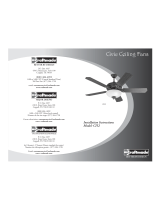 Craftmade Salerno SA52 Installation Instructions Manual
Craftmade Salerno SA52 Installation Instructions Manual
-
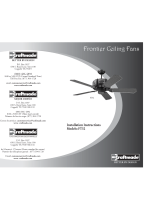 Craftmade Frontier FT52 Installation Instructions Manual
Craftmade Frontier FT52 Installation Instructions Manual
-
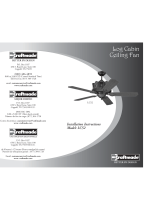 Craftmade Log Cabin LC52 Installation Instructions Manual
Craftmade Log Cabin LC52 Installation Instructions Manual
-
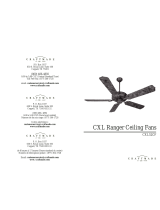 Craftmade TS52 Manuel utilisateur
Craftmade TS52 Manuel utilisateur
-
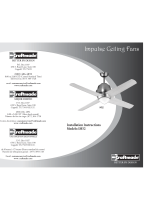 Craftmade Impulse IM52 Installation Instructions Manual
Craftmade Impulse IM52 Installation Instructions Manual
-
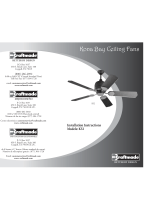 Craftmade K52 Installation Instructions Manual
Craftmade K52 Installation Instructions Manual
-
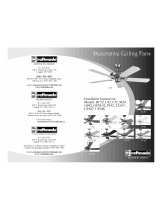 Craftmade UP108 Installation Instructions Manual
Craftmade UP108 Installation Instructions Manual
-
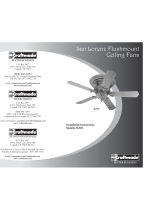 Craftmade San Lorenz SLH52 Installation Instructions Manual
Craftmade San Lorenz SLH52 Installation Instructions Manual
-
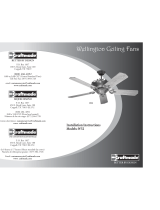 Craftmade Wellington W52 Installation Instructions Manual
Craftmade Wellington W52 Installation Instructions Manual
-
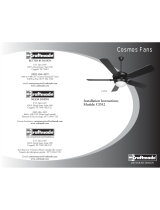 Craftmade CO52 Installation Instructions Manual
Craftmade CO52 Installation Instructions Manual
































